It was an amusing commentary—we didn’t know it was a sign of things to come. More than two decades later, when so many of us lament who De Niro has become—the still-dynamic actor who occasionally reminds us of how great he once reliably was—we should look back at this fairly disposable mob comedy he did with Billy Crystal. It was the moment he decided to become the King of Comedy, for better and (mostly) for worse.
“Analyze This” had a clever premise. A powerful mobster, Paul, is starting to be hampered by stress and anxiety, but he’s afraid to share that info with anyone, lest he be considered weak—especially by New York’s rival crime families. Through convoluted circumstances, he is clandestinely put in touch with a psychiatrist, Ben, who’s terrified at the prospect of treating a killer. But Ben quickly realizes it’s an offer he can’t refuse, which causes considerable problems since he’s about to marry his reasonably terrified girlfriend Laura.
Directed by Harold Ramis, who co-wrote the script with “The Larry Sanders Show” writer Peter Tolan and Oscar-winning filmmaker Kenneth Lonergan, “Analyze This” opened on March 5, 1999, just a few months after an ambitious new HBO drama with a similar conceit, “The Sopranos.” But at the time, “Analyze This” was the more high-profile project because of its stars, with Crystal playing the anxious, wisecracking Ben. (Lisa Kudrow, world-famous thanks to “Friends,” was cast as Laura.) For Paul, the filmmakers thought De Niro would be perfect—if he’d be up for it, of course.
“[Producer Paula Weinstein] said, ‘Do you think he would do it?,’” Crystal recalled around the film’s release. “I said, ‘I think he should do this because this is great for him. It’d be hilarious, and when you want scary, there’s nobody scarier. Who do you want to see do that? There’s a number of people that would be very good at this, but [they] are not him.’”
The idea wasn’t that crazy. Despite reuniting with director Martin Scorsese for 1995’s “Casino,” another engrossing mob tale, De Niro had sprinkled in some comedies in subsequent years, proving very amusing as a hair-trigger doofus criminal in “Jackie Brown” and a cynical spin doctor in “Wag the Dog.” Still, signing on to play Paul was the most overt acknowledgment of his cinematic persona—the casting was funny precisely because he’s Robert De Niro. And, ironically, there was a “Godfather” precedent to this type of cinematic subversion: For the 1990 comedy “The Freshman,” Marlon Brando played a mob boss who sure seems a lot like Vito Corleone. Now it was time for the man who played the younger Vito to take his turn tweaking his image.

